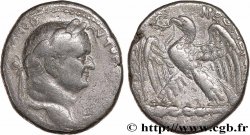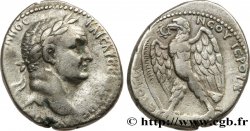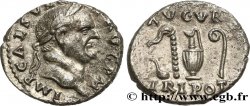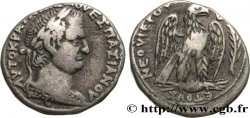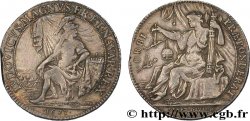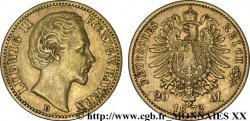v21_2390 - VESPASIANO Denier
MONNAIES 21 (2004)
Prezzo di inizio : 300.00 €
Valutazione : 550.00 €
Prezzo realizzato : 300.00 €
Numero di offerte : 1
Offerta maxima : 625.00 €
Prezzo di inizio : 300.00 €
Valutazione : 550.00 €
Prezzo realizzato : 300.00 €
Numero di offerte : 1
Offerta maxima : 625.00 €
Tipo : Denier
Data: 70
Nome della officina / città: Thrace, Byzance (Byzantium)
Metallo : argento
Titolo in millesimi : + 900 ‰
Diametro : 18 mm
Asse di coniazione : 6 h.
Peso : 3,48 g.
Grado di rarità : R2
Commenti sullo stato di conservazione:
Flan large. Beau portrait, de haut relief avec une faiblesse de frappe dans la chevelure. Revers de toute beauté, de haut relief, finement détaillé. Jolie patine de médaillier avec des reflets dorés
N° nelle opere di riferimento :
Diritto
Titolatura diritto : IMP CAESAR VESPAS AVG COS II TR P P P.
Descrittivo diritto : Tête laurée de Vespasien à droite (O*).
Traduzione diritto : “Imperator Cæsar Vespasianus Augustus Consul iterum Tribunicia Potestas”, (L'empereur césar Vespasien auguste consul pour la deuxième fois revêtu de la puissance tribunitienne).
Rovescio
Titolatura rovescio : CONCORDIA - AVG// ABY (MONOGRAMME EN EXERGUE).
Descrittivo rovescio : Concordia (la Concorde) ou Cérès voilée et drapée, trônant à gauche sur un siège à dossier richement décoré, tenant deux épis et un pavot de la main droite et une corne d'abondance de la main gauche.
Traduzione rovescio : “Concordia Augusti”, (La Concorde de l'auguste).
Commento
Bien que signalé très tôt (Cohen), nous n’avons pas pu retrouver d’illustration disponible pour ce type frappé à Byzance qui manque aux deux grandes collections du British Museum et du Cabinet des médailles de la BnF. Pour ce type, les auteurs du RPC ont relevé cinq exemplaires.
Although reported very early (Cohen), we have not been able to find any available illustration for this type struck in Byzantium, which is missing from the two major collections of the British Museum and the Cabinet des médailles of the BnF. For this type, the authors of the RPC have noted five examples
Although reported very early (Cohen), we have not been able to find any available illustration for this type struck in Byzantium, which is missing from the two major collections of the British Museum and the Cabinet des médailles of the BnF. For this type, the authors of the RPC have noted five examples








 Segnalare un errore
Segnalare un errore Stampate la pagina
Stampate la pagina Condividi mia selezione
Condividi mia selezione Fai una domanda
Fai una domanda Consegnare / vendere
Consegnare / vendere
 Descrittivo
Descrittivo